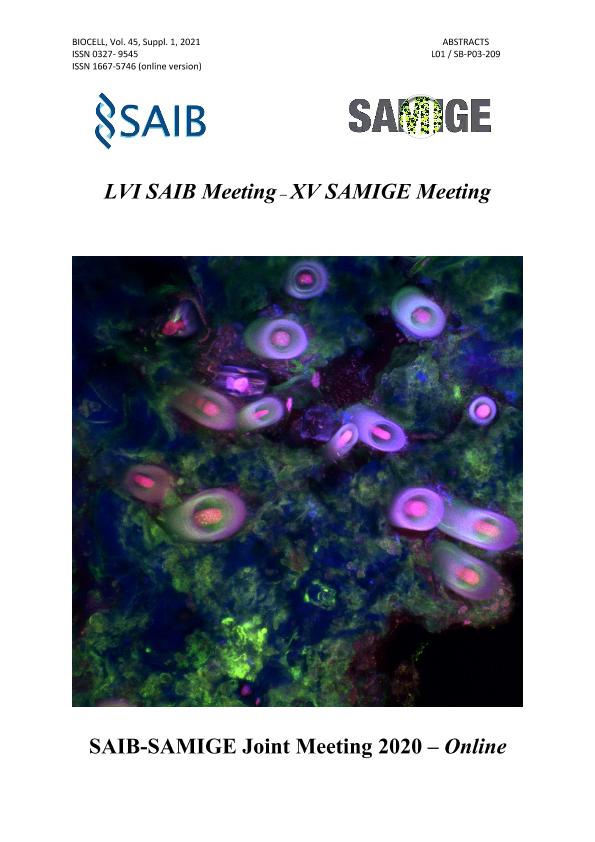Mostrar el registro sencillo del ítem
dc.contributor.author
Santiago Valtierra, Florencia Ximena

dc.contributor.author
Peñalva, Daniel Alejandro

dc.contributor.author
Luquez, Jessica Mariela

dc.contributor.author
Aveldaño, Marta Isabel

dc.contributor.author
Reyes, Juan Guillermo
dc.contributor.author
Oresti, Gerardo Martin

dc.date.available
2022-05-09T11:48:32Z
dc.date.issued
2020
dc.identifier.citation
Active calcium mobilization from a thapsigargin-sensitive pool by free 32.5n6 in spermatids; LVI Annual Meeting Argentine Society for Biochemistry and Molecular Biology (SAIB); XV Annual Meeting Argentinean Society for General Microbiology (SAMIGE); Mendoza; Argentina; 2020; 1-7
dc.identifier.issn
0327-9545
dc.identifier.uri
http://hdl.handle.net/11336/156881
dc.description.abstract
In their free form, long chain (C18–22) polyunsaturated fatty acids (PUFA), especially 20:4n−6, can modify calcium homeostasis in male germ cells. These cells also contain unusual n-6 very-long-chain (VLC) PUFA (28:4, 30:5, and 32:5), in non-hydroxy (n-V) and 2-hydroxy (h-V) forms, in their membrane sphingolipids. Potential biological roles of VLCPUFA, as free fatty acids (FFA), in the physiology of male germ cells are unknown. In this study we explored the ability of n-V FFA, and their h-V counterparts, to modify the intracellular calcium homeostasis in rat spermatids. After obtaining the n-V and h-V FFA from testicular sphingomyelin, their natural source, each group was separately added to spermatids suspensions at an 8 µM concentration. The n-V FFA increased the intracellular calcium concentration ([Ca2+]i) in spermatids several fold more intensely than did the h-V FFA. After isolating the components of n-V and h-V mixtures by HPLC to study the effect of each VLCPUFA, free n-32:5 was found to be the most active in increasing the [Ca2+]i, followed by n-30:5, while h-32:5 augmented it only slightly. In addition to fatty acid-specific, the response was dose-dependent. The rates of [Ca2+]i upsurge were independent of the presence of extracellular calcium. Pretreatment with thapsigargin inhibited the effect of n-32:5, suggesting that this FFA promotes the release of Ca2+ from intracellular calcium stores, mainly the endoplasmic reticulum. The n-V FFA did not seem to exert their effects through the G protein-coupled receptor GPR120, a putative receptor for free PUFA, as they occurred in the presence of a GPR120 inhibitor. Ceramides containing the same fatty acids did not modify [Ca2+]i, thus the observed [Ca2+]i increases may be attributed to the FFA themselves. The possibility that they occur after VLC-FFAs are converted into other bioactive compounds remains to be investigated. Our results revealed a biological activity of VLCPUFA that suggests a physiological role for these fatty acids. As VLCPUFA-mediated Ca2+ rises occurred in spermatids, they may activate Ca2+ signaling pathways with specific functional targets in germ cells differentiation.
dc.format
application/pdf
dc.language.iso
eng
dc.publisher
Tech Science Press

dc.rights
info:eu-repo/semantics/openAccess
dc.rights.uri
https://creativecommons.org/licenses/by-nc-sa/2.5/ar/
dc.subject
FREE VLCPUFA
dc.subject
CALCIUM HOMEOSTASIS
dc.subject
GERM CELLS
dc.subject
SPERMATOGENESIS
dc.subject.classification
Bioquímica y Biología Molecular

dc.subject.classification
Ciencias Biológicas

dc.subject.classification
CIENCIAS NATURALES Y EXACTAS

dc.title
Active calcium mobilization from a thapsigargin-sensitive pool by free 32.5n6 in spermatids
dc.type
info:eu-repo/semantics/publishedVersion
dc.type
info:eu-repo/semantics/conferenceObject
dc.type
info:ar-repo/semantics/documento de conferencia
dc.date.updated
2022-04-21T17:24:31Z
dc.identifier.eissn
1667-5746
dc.journal.volume
45
dc.journal.pagination
1-7
dc.journal.pais
Argentina

dc.journal.ciudad
Mendoza
dc.description.fil
Fil: Santiago Valtierra, Florencia Ximena. Consejo Nacional de Investigaciones Científicas y Técnicas. Centro Científico Tecnológico Conicet - Bahía Blanca. Instituto de Investigaciones Bioquímicas de Bahía Blanca. Universidad Nacional del Sur. Instituto de Investigaciones Bioquímicas de Bahía Blanca; Argentina. Universidad Nacional del Sur. Departamento de Biología, Bioquímica y Farmacia; Argentina
dc.description.fil
Fil: Peñalva, Daniel Alejandro. Consejo Nacional de Investigaciones Científicas y Técnicas. Centro Científico Tecnológico Conicet - Bahía Blanca. Instituto de Investigaciones Bioquímicas de Bahía Blanca. Universidad Nacional del Sur. Instituto de Investigaciones Bioquímicas de Bahía Blanca; Argentina. Universidad Nacional del Sur. Departamento de Biología, Bioquímica y Farmacia; Argentina
dc.description.fil
Fil: Luquez, Jessica Mariela. Consejo Nacional de Investigaciones Científicas y Técnicas. Centro Científico Tecnológico Conicet - Bahía Blanca. Instituto de Investigaciones Bioquímicas de Bahía Blanca. Universidad Nacional del Sur. Instituto de Investigaciones Bioquímicas de Bahía Blanca; Argentina. Universidad Nacional del Sur. Departamento de Biología, Bioquímica y Farmacia; Argentina
dc.description.fil
Fil: Aveldaño, Marta Isabel. Consejo Nacional de Investigaciones Científicas y Técnicas. Centro Científico Tecnológico Conicet - Bahía Blanca. Instituto de Investigaciones Bioquímicas de Bahía Blanca. Universidad Nacional del Sur. Instituto de Investigaciones Bioquímicas de Bahía Blanca; Argentina. Universidad Nacional del Sur. Departamento de Biología, Bioquímica y Farmacia; Argentina
dc.description.fil
Fil: Reyes, Juan Guillermo. Pontificia Universidad Católica de Chile; Chile
dc.description.fil
Fil: Oresti, Gerardo Martin. Consejo Nacional de Investigaciones Científicas y Técnicas. Centro Científico Tecnológico Conicet - Bahía Blanca. Instituto de Investigaciones Bioquímicas de Bahía Blanca. Universidad Nacional del Sur. Instituto de Investigaciones Bioquímicas de Bahía Blanca; Argentina. Universidad Nacional del Sur. Departamento de Biología, Bioquímica y Farmacia; Argentina
dc.relation.alternativeid
info:eu-repo/semantics/altIdentifier/url/http://www.saib.org.ar/index.php?q=node/562
dc.conicet.rol
Autor

dc.conicet.rol
Autor

dc.conicet.rol
Autor

dc.conicet.rol
Autor

dc.conicet.rol
Autor

dc.conicet.rol
Autor

dc.coverage
Nacional
dc.type.subtype
Reunión
dc.description.nombreEvento
LVI Annual Meeting Argentine Society for Biochemistry and Molecular Biology (SAIB); XV Annual Meeting Argentinean Society for General Microbiology (SAMIGE)
dc.date.evento
2020-11-02
dc.description.ciudadEvento
Mendoza
dc.description.paisEvento
Argentina

dc.type.publicacion
Journal
dc.description.institucionOrganizadora
Sociedad Argentina de Investigación en Bioquímica y Biología Molecular
dc.description.institucionOrganizadora
Sociedad Argentina de Microbiología General
dc.source.revista
Biocell

dc.date.eventoHasta
2020-11-05
dc.type
Reunión
Archivos asociados
